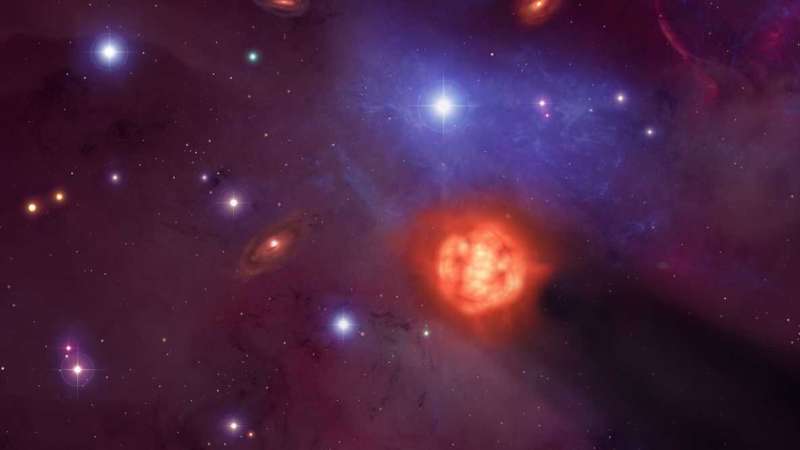This article has been reviewed according to Science X's editorial process and policies. Editors have highlighted the following attributes while ensuring the content's credibility:
fact-checked
peer-reviewed publication
trusted source
proofread
Older evolved stars passing through a star-forming region could have heated an early Earth

Researchers from the University of Sheffield and Imperial College London have spotted a "retired" asymptotic giant branch (AGB) star passing through a young star-forming region, something which was previously thought not to happen.
The researchers identified this interaction occurred in one of the places where they think stars like our sun must form, using the Gaia satellite, a 740m € mission to map the positions of billions of stars in our galaxy.
The most recent release of data from Gaia, Data Release 3, means that the research team can accurately pinpoint interloping stars. These interlopers are stars that did not form in the region, but are just passing through. The team has previously found young interloping stars, but now has found a much older, evolved star, known as an AGB, passing through a region.
Previous research has shown that these retired AGB stars produce large quantities of radioactively unstable chemical elements, Aluminum-26 and Iron-60. Aluminum-26 and Iron-60 were delivered to our young solar system at the epoch of planet formation, and are thought to dominate the early internal heating of Earth.
Ultimately, Aluminum-26 and Iron-60 may even have indirectly contributed to plate tectonics on our planet, which helps sustain a breathable atmosphere on Earth. The research team has calculated how much Aluminum-26 and Iron-60 from the AGB could be captured by a star like our sun as it formed its planets.
Dr. Richard Parker, a lecturer in Astrophysics in Department of Physics and Astronomy at the University of Sheffield, and the lead author of the study published in The Astrophysical Journal Letters, said, "Until now, researchers have been skeptical that these old, evolved stars could ever meet young stars that are forming planets, so this discovery reveals much more about the dynamics, relationships and journeys of stars.
"By showing that AGB stars can meet young planetary systems, we have shown that other sources of Aluminum-26 and Iron-60, such as the winds and supernovae of very massive stars, may not be required to explain the origin of these chemical elements in our solar system."
Dr. Christina Schoettler, an Astrophysics research associate in the Department of Physics at Imperial College London, identified the AGB star in the Gaia DR3 data. She says, "Gaia is revolutionizing our ideas about how stars form, and then subsequently move in the galaxy. This discovery of an old, evolved star in close proximity to young planet-forming stars is a wonderful example of the power of serendipity in scientific research."
The next step of this research is to search for other evolved stars in young star-forming regions to establish how common these retired interlopers are.
More information: Richard J. Parker et al, Isotopic Enrichment of Planetary Systems from Asymptotic Giant Branch Stars, The Astrophysical Journal Letters (2023). DOI: 10.3847/2041-8213/ace24a
Journal information: Astrophysical Journal Letters
Provided by University of Sheffield

















